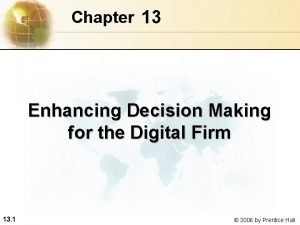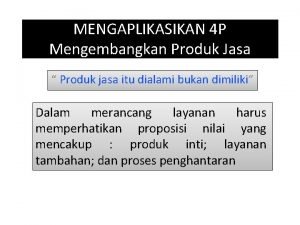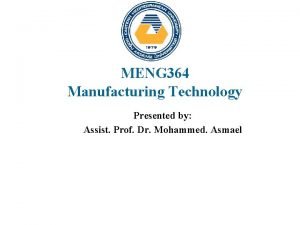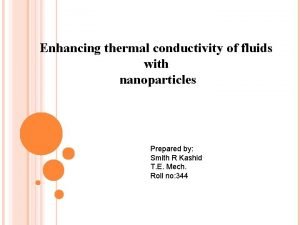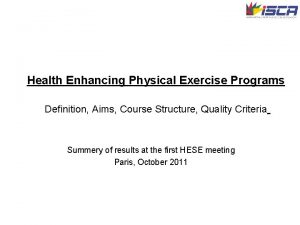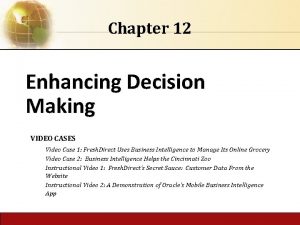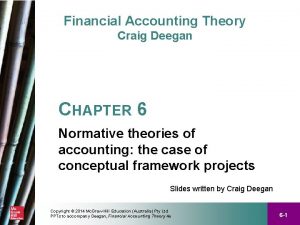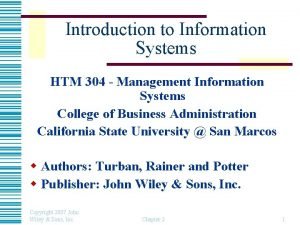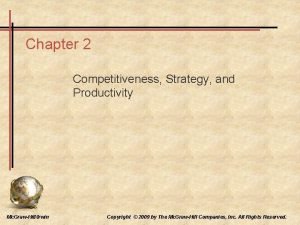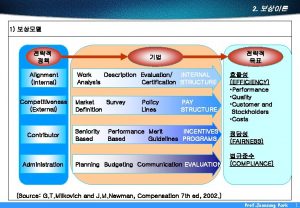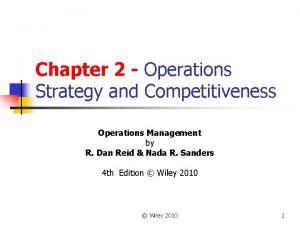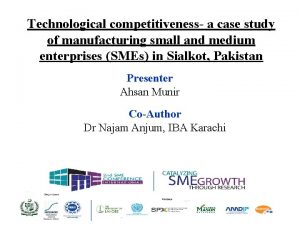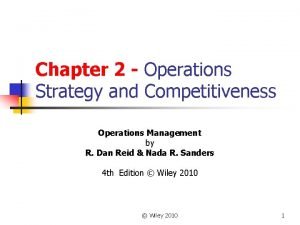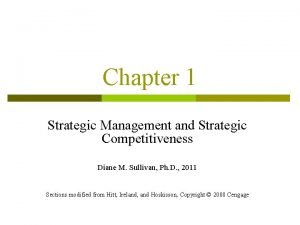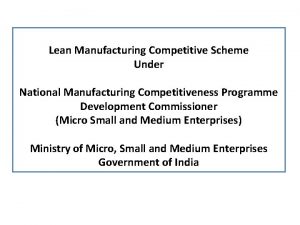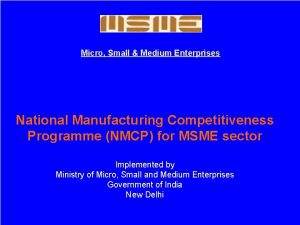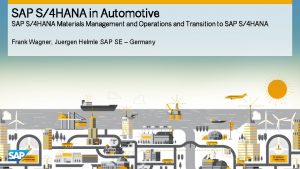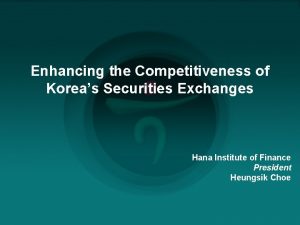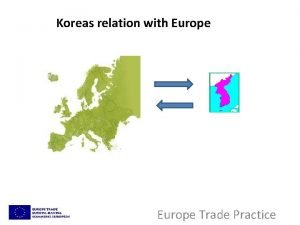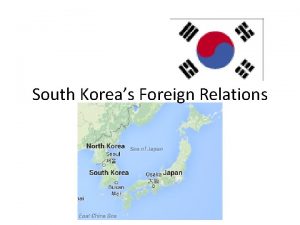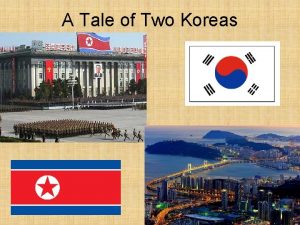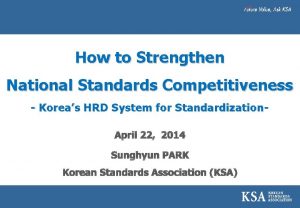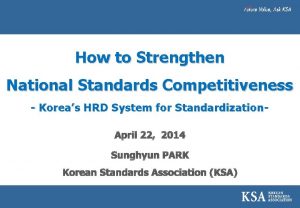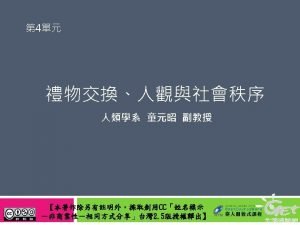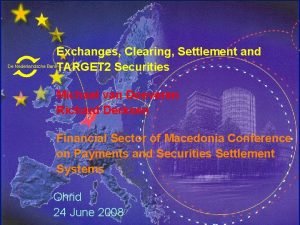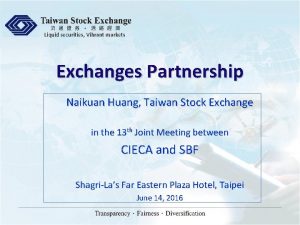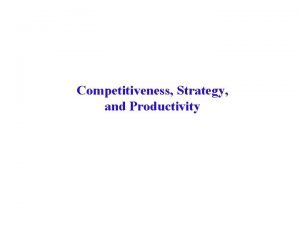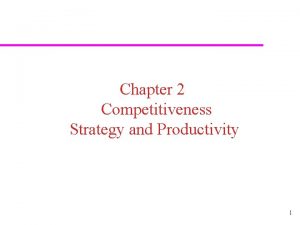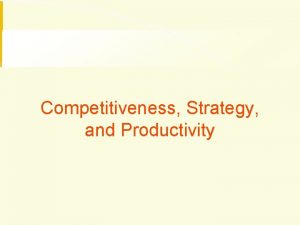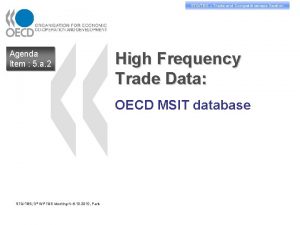Enhancing the Competitiveness of Koreas Securities Exchanges Hana








































- Slides: 40

Enhancing the Competitiveness of Korea’s Securities Exchanges Hana Institute of Finance President Heungsik Choe ■| 0

Table of Contents I. Overview of Securities Exchanges and Alternative Trading Systems II. How Conventional Exchanges Are Responding to the Rise of ATSs III. How ATSs Are Responding to the Evolving Exchange Sector IV. Growing Competition Between Exchanges and ATSs V. How Korea’s Exchange Sector Can Stay Competitive

Overview of Securities Exchanges Purpose q Provide markets for securities trading q Enable efficient price discovery q Establish rules for fair trading practices q Regulate the trading activities of members Functions Efficiency Functions Exchanges ensure that orders are executed and transactions settled in the fastest possible way. Exchanges help investors make informed, intelligent decisions Transparency by ensuring that information is disclosed in a timely, complete and accurate manner. Fairness Exchanges ensure that no investor has an unfair advantage over other market participants. | 2

Demutualization and Listing of Numerous Exchanges Late-1990 s to Mid-2000’s: Developments in the Exchange Sector Set the Stage for Key Regulatory Changes in 2007 Demutualization and Listing q Separates ownership and membership è Makes it easier to provide optimal services è Paves the way for exchange consolidation Gradual Progression M&A, Strategic Alliances and Partial Acquisitions q Helps achieve economies of scale and scope - Creates financial, operational and managerial synergies | 3

Major Forces of Change in the Exchange Industry Enabled the emergence of new low-cost entrants: l ATSs (MTFs) Globalization l I-Bank Internalizers (SIs) Liberalization of capital flows Regulatory Reform q US: Reg NMS q EU: Mi. FID l Low Trading Costs l Low Latency l Falling Market Shares l Falling Margins IT Technological Innovation Increased need for conventional exchanges to restructure | 4

Regulatory Reforms Level the Playing Field Reg NMS Mi. FID (Regulation National Market System) q Established in 2007 by the SEC q A series of initiatives designed to modernize and strengthen the national market system for equity securities. q Order Protection (or Trade Through) Rule (Markets in Financial Instrument Directive) q Europe’s analogue to Reg NMS; Effective starting in Nov 2007 q Cornerstone of the EC’s Financial Services Action Plan aimed at increasing competition and consumer protection in investment services q Harmonizes regulations of member states to better protect investors - Aims to guarantee best price execution q - Addresses fair and nondiscriminatory access to price quotations q Sub-Penny Rule - Establishes minimum pricing increments to address the practice of “stepping ahead” q - Client categorization and client order Access Rule handling q - Pre and post-trade transparency q Requires best execution - Assuring the best possible result including Market Data Rule cost, spread and likelihood of execution as well as execution price - Promoting the wide availability of market data and allocating revenues to the most useful data Enhances transparency by requiring the provision of sufficient trading data q Treats Systematic Internalizers (SIs) as miniexchanges l Alternative Trading Systems (ATS) l Multilateral Trading Facilities (MTF) l Systematic Internalizers (SI) | 5

Overview of Alternative Trading Systems Characteristics q q Various non-exchange trading venues have been launched as alternatives to conventional exchanges; their predominant function is the matching of transaction counterparties. ATS (US), MTF (Europe), PTS (Proprietary Trading Systems: Japan), Dark Pools, etc. è As of 2010, approximately 120 ATS were in operation. Strengths q Rapid order execution q Require few personnel but high-performance computing systems q Low costs of trading • Explicit costs: fees • Implicit costs: market timing costs and market impact costs Competition ATS Complement Exchange Listing & disclosure Reduced impact of block trades | 6

Algorithmic Trading and HFT (Appendix) HFT (High Frequency Trading) Algorithmic Trading A type of automated trading that breaks up large blocks of shares into smaller ones to manage risk and reduce the market impact of large trades q Also known as algo trading, black box trading or robo trading q Use of electronic platforms with an algorithm deciding on timing, price, or quantity q q Widely used by pension funds, mutual funds, and other buy side institutional traders and sell-side traders such as marketmakers providing liquidity Can be utilized in a variety of investment strategies, including market-making, arbitrage, or trend following pure speculation A sophisticated program trading platform that uses powerful computers to transact a large number of orders, a special class of algorithmic trading q Highly quantitative, uses computerized algorithms to analyze multiple markets and place orders based on market conditions q More sensitive to the execution speeds of markets q Positions held for a relatively short time and orders are often executed tens of thousands of times per day - According to the Aite Group, HFT accounted for 73% of all US equity trading volume in 2009 | 7

Ongoing Battle to Attract Heavy Trading Volume ATS US - BATS - Direct Edge • • • Europe Conventional Exchanges Asia - Chi-X Europe - BATSEurope - Turquoise Japan - Chi-X East • • • Competition for Survival • • • q Consolidation q System enhancements q Diversification q New Offerings Algo Trading HFT Market Making Statistical Arbitrage Event Arbitrage Technological Innovation | 8

Major Changes in Markets (2000~2009) Total number of trades in equity shares ⇒ +700% Weighted average value of trades ⇒ -85% q While the number of trades has exploded, the average value of trades has dropped significantly. q These phenomena have been largely due to the proliferation of HFT and algorithmic trading. Source : WFE * This average, computed on WFE members, has been weighted by the share of each member in the total value share trading. | 9

Table of Contents I. Overview of Securities Exchanges and Alternative Trading Systems II. How Conventional Exchanges Are Responding to the Rise of ATSs III. How ATSs Are Responding to the Evolving Exchange Sector IV. Growing Competition Between Exchanges and ATSs V. How Korea’s Exchange Sector Can Stay Competitive

How Conventional Exchanges Are Responding q M&A, Strategic Alliances and Partial Acquisitions q Acquisition and/or Establishment of ATS q Improvement of Trading Systems q Diversification of Business Models | 11

1. M&A, Strategic Alliances and Partial Acquisitions Ongoing Demutualization and Public Listings Benefits of Consolidation q Achieve economies of scale and scope q Better utilize network externalities → Enhanced market power As of 2011, most larger exchanges have been listed except for several Asian ones. From 2000 to 2009, securities exchanges have engaged in 73 M&A’s, 237 strategic alliances and 68 partial acquisitions across the globe. q Adapt to economic disturbances q Since 2006, the spread of M&A has accelerated, with 80% of exchange M&A activity concentrated in the period since then - Such activity has coincided with the rapid expansion of ATS and HFT - A majority of activity has been between stock exchanges and trading technology companies q M&A has been more active in Europe and North America than in Asia - Asia’s capital markets are at differing stages of development - Efforts to build an economic bloc in Asia have been slow | 12

Exchange M&A Activity Between 2000 and 2009 Type and Number of Mergers Between Exchanges q Horizontal By Economic Area q - Two Stock exchanges (22) - Europe (25) - Two Derivatives, Fixed Income and Commodities - North America (23) exchanges (8) - South America (2) - Stock exchange + Derivatives, Fixed Income and - Asia (15) Commodities exchange (8) - Two Clearing and Settlement Organizations (5) q - Africa (2) Vertical - Stock exchange + Clearing and Settlement Organization (5) - Stock exchanges + Trading Solutions Provider (18) Intra-Regional q Inter-Regional - Europe and North America (5) - Europe and Asia (1) - Derivatives, Fixed Income and Commodities exchanges + Trading Solutions Provider (5) | 13

Ten Largest Deals in the Exchange Sector in Europe and North America (Mar. 06 ~ Mar. 11) Deal Value Completion Date Target Nationality Acquirer Nationality (USD mil. , excl. debt) Jul. 07 CBOT US CME US 11, 648 Apr. 07 Euronext Netherlands NYSE US 10, 183 May 08 Bolsa de Mercadorias & Futures – BM&F Brazil Bovespa Brazil 8, 975 Aug. 08 Nymex US CME Group US 7, 909 Mar. 08 Omx Sweden NASDAQ US 4, 003 Dec. 07 International Securities Exchanges US Deutsche Borse Germany 2, 811 Oct. 07 Borsa Italia Italy LSE UK 2, 617 May 08 Montreal Exchange Canada TSX Group Canada 1, 070 Jan. 07 New York Board of Trade US International Exchange Inc. US 1, 066 Mar. 07 Archipelago Holdings US NYSE US 884 Source : “Trading blocs”, PWC, Aug. 2011 | 14

2. Acquisition and/or Establishment of ATS q Carried Out in Response to Fragmentation or Decreasing Market Share Exchange NYSE Group Date Target Class with Type Mar. 06 Archipelago ECN Acquisition Jul. 06 Match. Point Dark pool Acquisition Jan. 09 NYBX Dark pool Establishment BIDS Feb. 09 Smartpool Dark pool Establishment BNP Paribas, HSBC, JP Morgan Mar. 09 NYSE Arca Europe MTF Establishment Aug. 09 NYFIX ATS Acquisition Sep. 04 Brut ECN Acquisition Nov. 05 INET ECN Acquisition Nasdaq OMX Jun. 07 Nasdaq Intra-day and Post-close cross Dark pool Establishment Deutsche Borse Nov. 09 Xetra International Market MTF Establishment TMX Group Jul. 11 TMX Select ATS Establishment NYSE Euronext Nasdaq | 15

3. Improvement of Trading Systems Aims to achieve ultra-low latency and high levels of reliability and capacity q NYSE Euronext’s UTP (Universal Trading Platform) - Connectivity to all the NYSE Euronext markets through low latency global network - 150 -400 microseconds per roundtrip and 100, 000 orders per second q Nasdaq OMX’s INET trading system - Used across its US and European markets including equities and derivatives - 1 million messages per second at an average speed of sub-250 microseconds q LSE’s Millennium Exchange - Abandoned the troubled Trad. Elect system after a full day outage in 2007 - An average latency of less than 120 microseconds, making the LSE one of the fastest venues q ASX’s Pure. Match and Volume. Match - Adopting the Nasdaq OMX’s INET technology in response to Chi-X Australia’s entrance - Pure. Match is primarily for HFT while Volume. Match is for bulk order execution service. | 16

4. Diversification of Business Models Selling Exchange Technology and Market Services q Incumbent exchanges have tried to diversify revenues by exporting their trading platforms and IT systems to emerging markets. - NYSE Technologies, the IT services arm of NYSE Euronext, has provided trading platforms to emerging markets such as Warsaw and Qatar. - Nasdaq OMX’s trading platforms have powered many markets including SGX and ASX. - The ASEAN Trading Link, a venture between 6 Asian exchanges, was designed with assistance from NYSE Euronext. - LSE’s technology will be adopted for upgrades in South Africa and Mongolia. | 17

Table of Contents I. Overview of Securities Exchanges and Alternative Trading Systems II. How Conventional Exchanges Are Responding to the Rise of ATSs III. How ATSs Are Responding to the Evolving Exchange Sector IV. Growing Competition Between Exchanges and ATSs V. How Korea’s Exchange Sector Can Stay Competitive

How ATSs Are Responding q Transformation Into an Exchange q Acquisitions q Provision of New Services q Entry Into Asian markets | 19

1. Transformation Into an Exchange q Develop new revenue streams through the provision of various services such as listing - In Aug. 2008, BATS transformed itself into an exchange and became third largest in Jan. 2009 in terms of turnover value. Moreover, it has advanced into listing new indexes like BATS 1000. - In March 2010, Direct Edge received approval to convert into two separate exchanges: EDGA and EDGX - Alpha Trading Systems, the largest ATS in Canada, received approval to transform from an ATS to Alpha Exchange. | 20

2. Acquisitions q Due to the increasing number of ATS firms, competition has intensified, resulting in liquidation or acquisition by other exchanges and ATS - In July 2010, NASDAQ OMX Europe, the MTF of NASDAQ OMX, ceased operations. - In Feb. 2010, Turquoise, the well-known European MTF, was acquired by LSE. - In Nov. 2011, BATS Global completed acquisition of Chi-X Europe, the largest pan European trading venue. | 21

3. Provision of New Services q Operate multiple trading systems with different fee structures and pricing models - Direct Edge: EDGX is charging for removing liquidity - EDGA does not charge to provide or take liquidity BATS: BZX applies a “taker-maker” model, but BYX applies a “maker-taker” model q Offer smart order routing q Provide clients a choice among multiple CCP’s | 22

4. Entry Into Asian Markets q In Jul. 2010, Chi-X Japan launched PTS to trade Japanese-listed securities. Chi-X Japan is owned by Chi-X Global, a wholly-owned subsidiary of the Nomura Group. q In Oct. 2011, the monopolistic position of ASX was broken by the launch of Chi-X Australia, a subsidiary of Chi-X Global. q From Nov. 2008, a variety of darkpools such as Liquidnet, CLSA’s Bolcsec, and Goldman Sachs’ Sigma-X have been launched in Hong Kong. q Chi-East, the joint venture between Chi-X Global and SGX, commenced operations in Nov 2010 for the trading of selected securities listed in Singapore, Hong Kong, Australia, and Japan. | 23

Table of Contents I. Overview of Securities Exchanges and Alternative Trading Systems II. How Conventional Exchanges Are Responding to the Rise of ATSs III. How ATSs Are Responding to the Evolving Exchange Sector IV. Growing Competition Between Exchanges and ATSs V. How Korea’s Exchange Sector Can Stay Competitive

Fierce Competition Between Exchanges and ATSs q There is a large difference in market share between the largest exchange groups and the others, and the growth of ATS’s has been conspicuous. q When they announced their merger in Feb 2011, the combined market share of Chi-X and Bats Europe in European share trading exceeded 20%. q By end of 2010, BATS Global and Direct Edge had captured 21% of US equity market trading volume, placing them at number 3 and 4, respectively. Electronic Trading Order Book Value Traded in 2010 Source: “Trading blocs”, PWC, Aug. 2011 | 25

10 Years in Review (2000~2009) Market Capitalization ⇒ q +33% Though the Americas has the largest market cap, Asia. Pacific’s share has grown significantly. Total Value of Sharing Trading ⇒ q +61% While the Americas remains dominant in total trading, the Asia-Pacific’s share has more than doubled. Source: WFE | 26

Cyclical Trends in the Exchange Sector Repeating Cycle of Centralization and Fragmentation Monopoly of conventional exchange Fragmentation by ATS & MTF Ironically, regulators’ intention to break up the monopolies of exchanges has created larger global ones. Interestingly, consolidation and liquidity aggregation are not good for HFTs, as they benefit from highly fragmented markets that provide more arbitrage opportunities. Consolidation through M&A among exchanges and/or ATS …. . | 27

KRX’s Position in Cash Markets Largest Exchanges by Value of Share Trading in the Electronic Order Book in 2011 Exchange USD bn % Ch. (Yo. Y) 1 NYSE Euronext US 18, 027 1. 3 2 NASDAQ OMX US 12, 724 3 Tokyo Stock Exchange Group 4 Largest Exchanges by Total Value of Bonds Traded in 2011 Exchange USD bn % Ch. (Yo. Y) 1 BME Spanish Exchanges 17, 412 57. 7 0. 5 2 London Stock Exchange Group 5, 394 33. 9 3, 972 4. 9 3 Johannesberg Stock Exchange 2, 898 24. 9 Shanghai Stock Exchange 3, 658 -18. 6 4 NASDAQ OMX Nordic Exchange 2, 674 1. 8 5 Shenzhen Stock Exchange 2, 838 -20. 6 5 Colombia Stock Exchange 915 -19. 6 6 London Stock Exchange Group 2, 837 3. 5 6 Korea Exchange 747 47. 7 7 NYSE Euronext Europe 2, 134 5. 8 7 Oslo Bors 590 6. 6 8 Korea Exchange 2, 039 26. 2 8 Istanbul Stock Exchange 518 16. 2 9 Deutsche Börse 1, 758 8. 0 9 Mi. CEX 301 29. 3 10 TMX Group 1, 542 12. 7 10 Tel Aviv Stock Exchange 246 21. 2 Source: WFE | 28

KRX’s Position in Derivatives Markets Stock Index Options (2011) (millions of contracts, %) Exchange contracted traded % Ch. (Yo. Y) 1 Korea Exchange 3, 672 4. 1 2 National Stock Exchange India 871 64. 4 3 Eurex 468 36. 6 4 CBOE 320 18. 7 5 TAIFEX 2, 838 -20. 6 Securitized Derivatives (2011) (value of trading) Exchange contracted traded % Ch. (Yo. Y) 1 Hong Kong Exchanges 576 7. 8 2 Korea Exchange 289 -18. 4 3 Deutsche Börse 96 20. 0 4 SIX Swiss Exchange 59 55. 3 5 NYSE Euronext Europe 43 22. 8 Total Equity Derivates (2011) (millions of contracts, %) Exchange contracted traded % Ch. (Yo. Y) 1 Korea Exchange 3, 819 4. 4 2 Eurex 1, 404 18. 5 3 National Stock Exchange India 1, 221 37. 1 4 CBOE 1, 205 7. 7 5 NASDAQ OMX US 1, 177 19. 0 Source: WFE | 29

Table of Contents I. Overview of Securities Exchanges and Alternative Trading Systems II. How Conventional Exchanges Are Responding to the Rise of ATSs III. How ATSs Are Responding to the Evolving Exchange Sector IV. Growing Competition Between Exchanges and ATSs V. How Korea’s Exchange Sector Can Stay Competitive

A Proposed Future for Korea’s Exchange Sector Extend global networks Rational Regulatory Reforms Reduce technology gap Exchange Fair competition l Mutual Support Strategic Alliance US · Europe “Slow and Steady” Consolidation Asia-Pacific HFT Collaborate in trading systems development l ATS Strengthening of Infrastructure Enhance mutual accessibility to markets | 31

Recommendations for Korea’s Exchange Sector q Invest in and Jointly Develop IT System q Pave the Way for the Successful Introduction of ATSs q Devise New Products Within the Asia-Pacific q Offer a Variety of Services to Participants q Improve Derivatives Trading Platforms and Clearing & Settlement q Strengthen Strategic Alliances with the US and Europe q Encourage Consolidation Within the Asia-Pacific

1. Invest in and Jointly Develop IT Systems q Continue to invest substantial sums in IT systems - Work constantly to fulfill the demand for faster and more sophisticated trading technology - Enhance and reinforce the stability of the system to prevent market accidents such as the “flash crash” of May 2010 - Improve capacity and technology to attract large volumes of algorithmic traders, especially HFTs q Work with Asian partners to jointly develop trading platforms - Seek new revenue streams, for example, by exporting IT systems or providing assistance in the opening of securities exchanges in Asian emerging markets - The future consolidation of Asian exchanges will be easier and more efficient if common trading platforms are used. | 33

2. Pave the Way for the Successful Introduction of ATS q Ensure that ATSs are launched successfully to build up internal competitiveness - There is a need to prepare ATSs for successful launching before the amendment to the “Financial Investment Services and Capital Market Act” is ratified. - It is advisable to establish holding companies owned by Asian financial institutions that can own and operate ATSs in the Asia-Pacific. * Large Asian investment banks and brokerage firms may be good candidates. q Learn how to manage ATSs through alliances - Strengthen ties with larger exchanges, especially ones having significant experience operating an ATS | 34

3. Devise New Products Within the Asia-Pacific q Encourage Asia-Pacific countries to cross-list securities and trade a range of products - As a first step, the representative stocks of each country should be considered for dual-listing and/or cross-trading. * KRX has proposed dual-listings with China and Honk Kong, and has entered a cross-trading agreement with Japan that covers all stocks and is set to commence in November 2012. - Create a combined ETF that incorporates similar sectors from each exchange, as the listing criteria are easier to meet in spite of differing regulations and cultures - Take advantage of the rapid growth of derivatives in the region to devise new derivative products that can attract the attention of multiple countries | 35

4. Offer a Variety of Services to Participants q Accept various types of orders from large participants - Diversify the types of orders accepted, especially for large-volume traders such as algorithmic traders - A good example might be iceberg orders, which help to mitigate market impact. q Offer services aimed at enhancing the speed of order execution - The popularity of low latency trading has been giving a good chance for growth of exchanges offering co-location services. - DMA (Direct Market Access) might be a service offered that enables sophisticated investors to place orders directly on the exchange order book for high speed execution. | 36

5. Improve Derivatives Trading Platforms and Clearing & Settlement q Prepare for standardization and centralization of OTC derivatives and their trading platforms - In accordance with the US Dodd-Frank Act and Mi. FID, many derivative products will be traded through exchanges and cleared through clearing houses. - This will provide a great opportunity for exchange groups that focus primarily on equities. - Also, attention should be paid to OTFs (Organised Trading Facilities) and SEFs (Swap Executive Facilities), the mirror images of MTF and ATS in cash market, respectively, as potential rivals to exchanges. q Enhance systems for clearing and settlement, as these might provide an important competitive edge in the near future - In Sep. 2010, the EC published the European Market Infrastructure Regulation (EMIR), which aims to increase stability in OTC derivative markets. * It aims to ensure that OTC contracts are centrally cleared and trading parties able to select among a variety of clearing houses. - If clearing platforms are more open, it may be easier for specialist clearers to carve out a competitive position. | 37

6. Strengthen Strategic Alliances with the US and Europe q Extend global networks through strategic alliances with US and Europe trading venues - Construct 24 -hour trading systems through network linkages * At present, KRX, CME(US), and Eurex (Europe) are offering 24 -hour trading of KOSPI 200 futures - Strengthen strategic alliances through cross-listings and cross-trading q Actively embrace advanced systems and trading technologies -To shorten the time required to develop systems and technology, it is advisable to learn from the experiences of the advanced systems. | 38

7. Encourage Consolidation Within the Asia-Pacific q Push ahead toward gradual consolidation of trading venues in Asia-Pacific - The countries of the Asia-Pacific differ widely not only in terms of language and cultures, but also in terms of their capital markets and regulatory environments. - Nevertheless, the trend toward integration seems to be established and may even accelerate in the near future. * ASEAN is promoting cross-border collaboration through its upcoming “ASEAN Trading Link, ” which is made-up of seven stock exchanges from Indonesia, Malaysia, the Philippines, Singapore, Thailand Vietnam (2). The 210 stocks representing the 30 blue chips from each exchange will be available for trading on a common platform. * The BRICS and Hong Kong will start to cross list their derivatives indices from Mar. 2012 in a bid to expand their product offerings. | 39
 Six exchanges dialogue
Six exchanges dialogue Exchanges over trillion trading volume this
Exchanges over trillion trading volume this The role of internet exchanges and peering
The role of internet exchanges and peering Enhancing decision making
Enhancing decision making Contoh pengembangan produk jasa
Contoh pengembangan produk jasa Property enhancing process in manufacturing
Property enhancing process in manufacturing Enhancing professional practice
Enhancing professional practice History of performance enhancing drugs
History of performance enhancing drugs Enhancing thermal conductivity of fluids with nanoparticles
Enhancing thermal conductivity of fluids with nanoparticles Enhancing a presentation with multimedia
Enhancing a presentation with multimedia Enhancing professional practice
Enhancing professional practice Health enhancing definition
Health enhancing definition Enhancing the performance of grade vi-c
Enhancing the performance of grade vi-c Enhancing professional practice: a framework for teaching
Enhancing professional practice: a framework for teaching Enhancing personal effectiveness
Enhancing personal effectiveness Enhancing decision making
Enhancing decision making Privacy-enhancing computation
Privacy-enhancing computation Four enhancing qualitative characteristics
Four enhancing qualitative characteristics The best known framework for analyzing competitiveness is
The best known framework for analyzing competitiveness is Competitiveness strategy and productivity
Competitiveness strategy and productivity What is external competitiveness
What is external competitiveness Unitless measure of productivity
Unitless measure of productivity Internal competitiveness
Internal competitiveness Scale based strategy
Scale based strategy Competitiveness, strategy and productivity
Competitiveness, strategy and productivity Io model strategic management
Io model strategic management Chapter 2 operations strategy and competitiveness
Chapter 2 operations strategy and competitiveness Technological competitiveness
Technological competitiveness Productivity and competitiveness in operations management
Productivity and competitiveness in operations management Strategic competitiveness
Strategic competitiveness What is strategic competitiveness
What is strategic competitiveness Apec services competitiveness roadmap
Apec services competitiveness roadmap Chapter 2 operations strategy and competitiveness
Chapter 2 operations strategy and competitiveness Lean manufacturing competitiveness scheme
Lean manufacturing competitiveness scheme How do you measure productivity
How do you measure productivity Defining competitiveness
Defining competitiveness Pay mix policy alternatives
Pay mix policy alternatives National manufacturing competitiveness programme
National manufacturing competitiveness programme Competitiveness strategy and productivity
Competitiveness strategy and productivity Hana porkertová
Hana porkertová Sap s4 hana automotive
Sap s4 hana automotive



